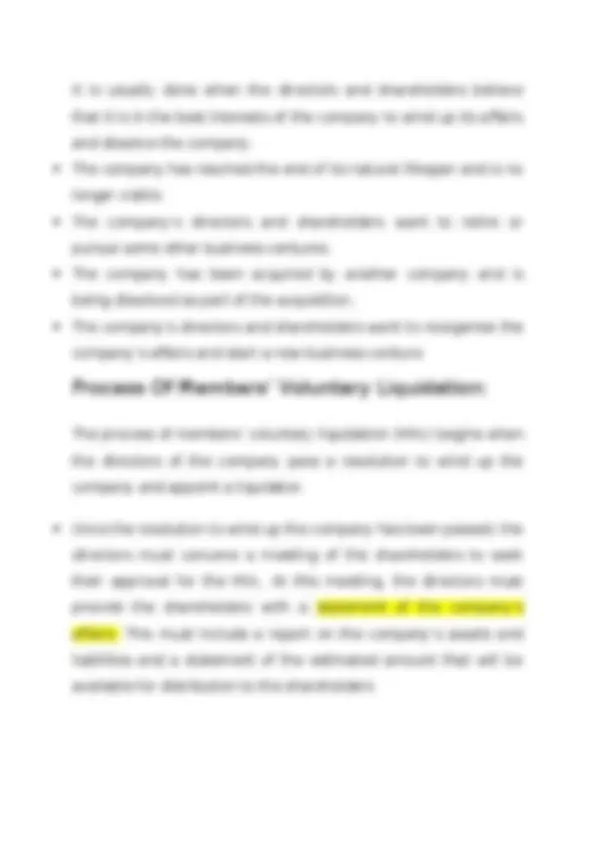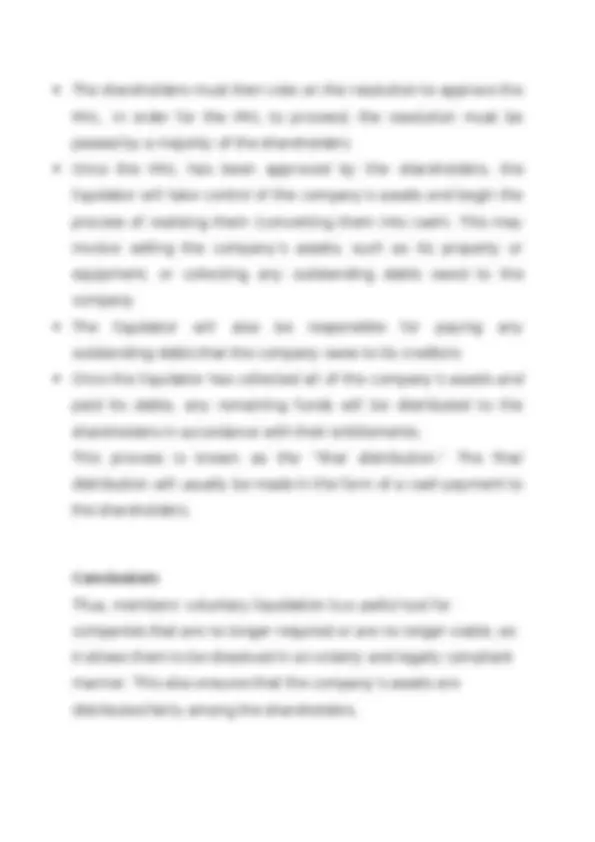




Study with the several resources on Docsity

Earn points by helping other students or get them with a premium plan


Prepare for your exams
Study with the several resources on Docsity

Earn points to download
Earn points by helping other students or get them with a premium plan
Community
Ask the community for help and clear up your study doubts
Discover the best universities in your country according to Docsity users
Free resources
Download our free guides on studying techniques, anxiety management strategies, and thesis advice from Docsity tutors
Liquidation is the process of closing a business and distributing its assets to creditors and shareholders. Liquidation can be voluntary, or compulsory. In the case of voluntary, it is initiated by the company’s directors or shareholders. It may be court-ordered in the case of compulsory liquidation. The purpose of liquidation is to dissolve the company, sell its assets, and use the proceeds to pay off its debts in an organised and equitable way. There are two types of voluntary liquidation namely, members’ voluntary liquidation and creditors’ voluntary liquidation. In general, the process of liquidation can be complicated and might take a long time to complete. The specific steps involved will vary depending on the type of liquidation and the laws of the country in which the company is located.
Typology: Summaries
1 / 4

This page cannot be seen from the preview
Don't miss anything!



Winding up a company means to end all business affairs in order to permanently close a company. Winding up is a process by means of which the affairs of a company are wound up in a manner to dissolve the company and put an end to the life of a Company. In the process of winding up, the company’s assets and properties are administered for the benefit of the members and creditors of the Company. The administrator, called liquidator, realises its assets, pays its debts and finally distributes the surplus, if any, among the members/creditors, in accordance with their right as provided in the article of the Company. The term “Winding Up” and “liquidation” are used interchangeably. Liquidation is the process of closing a business and distributing its assets to creditors and shareholders. Liquidation can be voluntary, or compulsory. In the case of voluntary, it is initiated by the company’s directors or shareholders. The purpose of liquidation is to dissolve the company, sell its assets, and use the proceeds to pay off its debts in an organised and equitable way. There are two types of voluntary liquidation namely, members’ voluntary liquidation and creditors’ voluntary liquidation.
The provisions concerning to Voluntary Winding up of Company was specified in section 304-325 of Companies Act, 2013 although these provisions not at all notified. As the IBC got the president assent on 28/05/2016 as per section 255 and schedule XI of IBC the sections of Voluntary winding up “Omitted” from Companies Act, 2013. Prior to 1st April, 2017 voluntary Winding up was ongoing in Companies Act, 1956. Section 425 to Section 520 of the Companies Act, 1956 (Act,
Members’ voluntary liquidation (MVL) is a process that allows a solvent company to be dissolved and its assets distributed to its shareholders. This is a kind of voluntary liquidation process that is started by the company’s directors and requires the approval of the company’s shareholders.
Members’ voluntary liquidation is typically done when the company is solvent, meaning it is able to pay its debts as they come due.
The shareholders must then vote on the resolution to approve the MVL. In order for the MVL to proceed, the resolution must be passed by a majority of the shareholders Once the MVL has been approved by the shareholders, the liquidator will take control of the company’s assets and begin the process of realising them (converting them into cash). This may involve selling the company’s assets, such as its property or equipment, or collecting any outstanding debts owed to the company The liquidator will also be responsible for paying any outstanding debts that the company owes to its creditors Once the liquidator has collected all of the company’s assets and paid its debts, any remaining funds will be distributed to the shareholders in accordance with their entitlements. This process is known as the “final distribution.” The final distribution will usually be made in the form of a cash payment to the shareholders. Conclusion: Thus, members’ voluntary liquidation is a useful tool for companies that are no longer required or are no longer viable, as it allows them to be dissolved in an orderly and legally compliant manner. This also ensures that the company’s assets are distributed fairly among the shareholders.